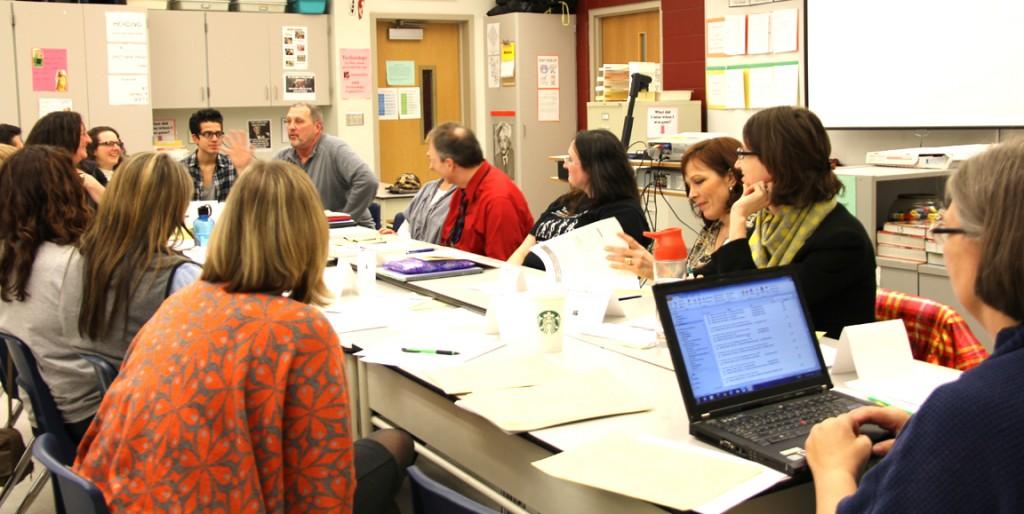The Edmonds School District Wellness Committee met Feb. 27 to discuss the future of vending machines in schools, which have to meet new nutritional standards set by the United States Department of Agriculture (USDA) starting next school year.
These changes will have an impact of the types of food schools are able to put in vending machines and sell at school in general. Also, any change in vending machine content and usage could potentially impact ASB funding.
The choice for the Wellness Committee was between supplying the vending machines with foods that met the USDA’s standards, which could then continue to run all day, or keep the machines filled with foods that don’t meet the nutritional standards. If this was the case, the machines could only be on for use from 30 minutes after school until 12 a.m. every day.
After discussion, the members of the committee decided to replace the food in all student-used vending machines with food that follows USDA standards. This will take effect in the 2014-2015 school year.
During the meeting, different ideas circulated the room on which path to take. For some members, such as Meadowdale High School ASB Advisor and Athletic Director Beth Marriot, keeping the same foods in the vending machines but not running them during school sounded favorable due to the way vending machines are currently used at Meadowdale. Limiting usage time would not be a huge change.
However, at schools like MTHS where vending machines are constantly in use, only having the machines on for after-school hours would make a substantial difference.
This brought on the topic that maybe there shouldn’t be a blanket policy for which rout to take because all the schools have implemented vending machines in different ways.
Some members weren’t as concerned about sales dropping with the introduction of healthier foods.
“Whatever you put in the machine, [the students] are going to buy it,” Marriot said.
Ultimately, the decision came down to the desire for consistency. The Wellness Committee decided that replacing all the snacks with food that is up to par with the USDA standards and getting rid of the current snacks all at once is the most effective way to make the transition.
Another decision the committee had to make was whether or not to make the rules on vending machines stricter.
For example, even though the USDA regulations don’t allow there to be regular soda sold in high schools, they don’t limit the sale of diet soda. In some studies, diet soda has been shown to be worse for the human body than regular soda, so this extra limitation was brought to consideration by the committee.
Around the board, the members opposed the proposition of taking away diet soda. Even those who were against drinking diet soda said that they shouldn’t take it upon themselves to make the regulations stricter.
“The USDA regulations are already making it hard enough. We shouldn’t restrict [the vending machine policy] any more than it already is,” Edmonds School Board member Diana White said.
Also, the committee talked about having the vending company, Advantage Vending and Distribution, bring samples of the USDA regulated food in order to see what options are available.
The members decided that there should be a meeting at one of the district high schools, allowing students to look at or try the different food options and give their input on what they would and wouldn’t purchase. District Food Service Program Director Barb Lloyd hopes to schedule an opportunity like this before the end of March.
Edmonds School District ASB funding is highly reliant on vending revenue. At MTHS alone, the vending machines made $20,465 in the 2012-2013 school year. According to the Wellness Committee handout, the entire district made a total of $76,320 in the same year.
Changing the contents of the machines could potentially have major effect on these numbers and consequentially on the yearly ASB budget.
“There are two trains of thought. One is that the change [in vending machine contents] will have a negative impact on ASB revenue. The second is that kids will buy and eat whatever is in the vending machines,” ESD Executive Director of Business and Operations Stewart Mhyre said.
“We will just have to wait and see,” Mhyre continued.
If ASB revenue is decreased, it could mean extreme changes for extracurricular activities. According to MTHS ASB Advisor and Athletic Director Kim Stewart, a lack of income from vending machines would lead to decreased ASB funding, which may cause the school to drop clubs and programs.
Some of these health regulations for snack items include that the food must be a whole grain product, have a fruit, vegetable, dairy product, or protein as the first ingredient, include a certain amount of fruits and/or vegetables, or contain 10 percent of the Daily Value of one of the nutrients of public health concerns, namely calcium, potassium, vitamin D and dietary fiber.
According to USDA’s “All Foods Sold In Schools” Standards, there are also limitations on amounts of calories, sodium, fats and sugars.
USDA’s Smart Snacks in School standards apply to all foods sold in schools. This means that the Hawk Shop and café will also see a change in menu as of next year.
The purpose of these regulations for food sold at school, called Smart Snacks in School, is to improve health among kids and lessen the risks of diseases like diabetes and heart disease, according to Lloyd.
“I hope that the students will recognize why changes are being made and that we are not just trying to make their lives miserable by taking things they like away. There’s a purpose: it’s their long-term health,” Lynnwood Elementary School nurse Mary Johann said.
Whether it’s a positive or negative change, this year’s candy and chips will soon be replaced with healthier alternatives.
For more information about USDA’s “All Foods Sold in Schools” Standards, go here.







